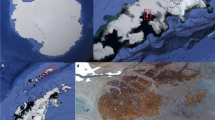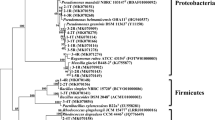Abstract
We characterized the diversity of cultivable fungal assemblages associated with the bryospheres of the bipolar mosses Polytrichastrum alpinum and Polytrichastrum juniperinum resident in King George Island, South Shetland Islands, Maritime Antarctica. From different parts of the mosses, 160 fungal isolates were obtained and identified using molecular biology methods as 43 taxa of 28 distinct genera. Antarctomyces psychrotrophicus, Mrakia gelida, Pseudogymnoascus sp., Melanodiplodia sp., and Vishniacozyma victoriae were the dominant taxa and displayed the highest values of frequency. Ecological diversity indices showed that the fungal assemblages were high but ranged among the mosses. Fungi of the bryospheres of both mosses showed different colonization patterns. Only A. psychrotrophicus, M. gelida, Pseudogymnoascus sp., and Leotiomycetidae sp. occurred as endophytes, epiphytes, and in the rhizoidosphere of P. alpinum. In contrast, the bryosphere of P. juniperinum did not show a single common fungus across its different portions. Our results show that the bryosphere of the bipolar Antarctic mosses seem to represent an interesting hostspot of fungal diversity dominated by cosmopolitan cold-adapted and endemic species recognized as symbionts and decomposer species. The high fungal diversity detected suggests that the Antarctic mosses may offer a protected microhabitat (bryosphere) favorable for the survival, dispersal, and colonization of symbionts and decomposer fungi in the different extreme environments of Antarctica.

Similar content being viewed by others
References
Altschul SF, Madden TL, Schäffer AA et al (1997) Gapped BLAST and PSI-BLAST: a new generation of protein database search programs. Nucleic Acids Res 25:3389–3402
Alves IMS, Gonçalves VN, Oliveira FS et al (2019) The diversity, distribution, and pathogenic potential of cultivable fungi present in rocks from the South Shetlands archipelago, Maritime Antarctica. Extremophiles 23:237–336
Azmi OR, Seppelt RD (1998) The broad-scale distribution of microfungi in the Windmill Islands region, continental Antarctica. Polar Biol 19:92–100
Bardou P, Mariette J, Escudié F et al (2014) Jvenn: an interactive Venn diagram viewer. BMC Bioinform 15:293
Bednarek-Ochyra H, Váňa J, Ochyra R et al (2000) The liverwort flora of Antarctica. Polish Academy of Sciences Institute of Botany, Cracow
Brunati M, Rojas JL, Sponga F et al (2009) Diversity and pharmaceutical screening of fungi from benthic mats of Antarctic lakes. Mar Genom 2:43–50
Carvalho CR, Gonçalves VN, Pereira CB et al (2012) The diversity, antimicrobial and anticancer activity of endophytic fungi associated with the medicinal plant Stryphnodendron adstringens (Mart***) Coville (Fabaceae) from the Brazilian savannah. Symbiosis 57:95–107
Carvalho CR, Santiago IF, Coelho LC et al (2019) Fungi associated with plants and lichens of Antarctica. In: Rosa LH (ed) Fungi of Antarctica: diversity, ecology and biotechnological applications. Springer, Cham, pp 165–200
Castellani A (1967) Maintenance and cultivation of common pathogenic fungi in distilled water. J Trop Med Hygien 42:181–184
de Menezes GCA, Amorim SS, Gonçalves VN et al (2019) Diversity, distribution, and ecology of fungi in the seasonal snow of Antarctica. Microorganisms 7:445–460
de Menezes GCA, Porto BA, Amorim SS et al (2020) Fungi in glacial ice of Antarctica: diversity, distribution and bioprospecting of bioactive compounds. Extremophiles. https://doi.org/10.1007/s00792-020-01161-5
Eighls J (1833) Description of a new crustaceous animal found on the shores of the South Shetland Islands, with remarks on their natural history. Trans Albany Inst 2:53–69
Figueredo HM, Gonçalves VN, Godinho VM et al (2019) Diversity and ecology of cultivable fungi isolated from the thermal soil gradients in Deception Island, Antarctica. Extremophiles 24:219–225
Furbino LE, Pellizzari FM, Neto PC et al (2017) Isolation of fungi associated with macroalgae from maritime Antarctica and their production of agarolytic and carrageenolytic activities. Polar Biol 41:527–535
Glass NL, Donaldson GC (1995) Development of primer sets designed for use with the PCR to amplify conserved genes from filamentous ascomycetes. Appl Environ Microbiol 61:1323–1330
Godinho VM, Paula MTR, Silva DAS et al (2019) Diversity and distribution of hidden cultivable fungi associated with marine animals of Antarctica. Fungal Biol 124:1–10
Gomes ECQ, Godinho VM, Silva DAS et al (2018) Cultivable fungi present in Antarctic soils: taxonomy, phylogeny, diversity, and bioprospecting of antiparasitic and herbicidal metabolites. Extremophiles 22:381–393
Gonçalves VN, Cantrell CL, Wedge DE et al (2015) Fungi associated with rocks of the Atacama Desert: taxonomy, distribution, diversity, ecology and bioprospection for bioactive compounds. Environ Microbiol 18:232–245
Hammer Ø, Harper DAT, Ryan PD (2001) PAST: Paleontological statistics software package for education and data analysis. Palaeontol Electron 4:9
Hughes KA, Lawley B (2003) A novel Antarctic microbial endolithic community within gypsum crusts. Environ Microbiol 5:555–565
Kerry E (1990) Microorganisms colonizing plants and soil subjected to different degrees of human activity, including petroleum contamination, in the Vestfoid Hills and MacRobertson Land, Antarctica. Polar Biol 10:423–430
Kirk PM, Cannon PF, Minter DW et al (2008) Dictionary of the fungi, 10th edn. CAB International, Wallingford
Kurtzman CP, Fell JW, Boekhout T et al (2011) Methods for isolation, phenotypic characterization and maintenance of yeasts. In: Kurtzman CP, Fell JW, Boekhout T (eds) The yeasts, a taxonomic study. Elsevier, Amsterdam, pp 87–110
Lachance MA, Bowles JM, Starmer WT et al (1999) Kodamaea kakaduensis and Candida tolerans, two new yeast species from Australian Hibiscus flowers. Can J Microbiol 45:172–177
Lindo Z, Gonzalez A (2010) The bryosphere: an integral and influential component of the Earth’s biosphere. Ecosystems 13:612–627
Ochyra R, Lewis-Smith RI, Bednarek-Ochyra H (2008) The illustrated moss flora of Antarctica. Cambridge University Press, Cambridge
Ogaki MB, Teixeira DR, Vieira R et al (2020) Diversity and bioprospecting of cultivable fungal assemblages in sediments of lakes in the Antarctic Peninsula. Fungal Biol. https://doi.org/10.1016/j.funbio.2020.02.015
Rosa LH, Zani CL, Cantrell CL et al (2019) Fungi in Antarctica: diversity, Ecology, effects of climate change, and bioprospecting for bioactive compounds. In: Rosa LH (ed) Fungi of Antarctica: diversity, ecology and biotechnological applications. Springer, Cham
Rosa LH, Vaz ABM, Caligiorne RB et al (2009) Endophytic fungi associated with the Antarctic Grass Deschampsia antarctica Desv. (Poaceae). Polar Biol 32:161–167
Santiago IF, Rosa CA, Rosa LH (2017) Endophytic symbiont yeasts associated with the Antarctic angiosperms Deschampsia antarctica and Colobanthus quitensis. Polar Biol 40:177–183
Santiago IF, Soares MA, Rosa CA et al (2015) Lichensphere: a protected natural microhabitat of the non-lichenised fungal communities living in extreme environments of Antarctica. Extremophiles 19:1087–1097
Tosi S, Casado B, Gerdol R (2002) Fungi isolated from Antarctic mosses. Polar Biol 25:262–268
Vaz ABM, Rosa LH, Vieira MLA et al (2011) The diversity, extracellular enzymatic activities and photoprotective compounds of yeasts isolated in Antarctica. Braz J Microbiol 42:937–947
Vishniac HS (2006) Yeast biodiversity in the Antarctic. In: Rosa CA, Péter G (eds) Biodiversity and ecophysiology of yeasts. Springer, Berlin, pp 419–440
Wang M, Tian J, Xiang M et al (2017) Living strategy of cold-adapted fungi with the reference to several representative species. Mycology 8:178–188
White TJ, Bruns TD, Lee SB et al (1990) Amplification and direct sequencing of fungal ribosomal RNA genes for phylogenetics. In: Innis MA, Gelfand DH, Sninsky JJ, White TJ (eds) PCR protocols: a guide to methods and applications. Academic Press, San Diego, pp 315–322
Yu NH, Kim JA, Jeong MH et al (2014) Diversity of endophytic fungi associated with bryophyte in the Maritime Antarctic (King George Island). Polar Biol 37:27–36
Zhang T, Xiang HB, Zhang YQ et al (2013a) Molecular analysis of fungal diversity associated with three bryophyte species in the Fildes Region, King George Island, Maritime Antarctica. Extremophiles 17:757–765
Zhang T, Zhang YQ, Liu HY et al (2013b) Diversity and cold adaptation of culturable endophytic fungi from bryophytes in the Fildes Region, King George Island, Maritime Antarctica. FEMS Microbiol Lett 341:52–61
Acknowledgments
We acknowledge the financial support from CNPq PROANTAR 442258/2018–6, INCT Criosfera II, CAPES (88887.136384/2017–00 and 88887.314457/2019–00), CNPq, FAPEMIG, and FNDCT.
Author information
Authors and Affiliations
Contributions
All of the authors contributed substantially to the present research, which was prepared as an original article.
Corresponding author
Ethics declarations
Conflict of interest
All authors declare that they have no conflict of interest.
Additional information
Publisher's Note
Springer Nature remains neutral with regard to jurisdictional claims in published maps and institutional affiliations.
Electronic supplementary material
Below is the link to the electronic supplementary material.
Rights and permissions
About this article
Cite this article
de Carvalho, C.R., Ferreira, M.C., Gonçalves, V.N. et al. Cultivable fungi associated with bryosphere of bipolar mosses Polytrichastrum alpinum and Polytrichum juniperinum in King George Island, South Shetland Islands, Maritime Antarctica. Polar Biol 43, 545–553 (2020). https://doi.org/10.1007/s00300-020-02658-7
Received:
Revised:
Accepted:
Published:
Issue Date:
DOI: https://doi.org/10.1007/s00300-020-02658-7




